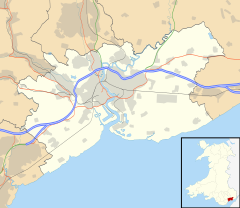Christchurch, Newport
Christchurch
|
|
|---|---|
 Holy Trinity Church, Chrischurch |
|
| Christchurch shown within Newport | |
| Population | 233 |
| Principal area | |
| Ceremonial county | |
| Country | Wales |
| Sovereign state | United Kingdom |
| Post town | NEWPORT |
| Postcode district | NP18 1 |
| Dialling code | 01633 Maindee exchange |
| Police | Gwent |
| Fire | South Wales |
| Ambulance | Welsh |
| EU Parliament | Wales |
| UK Parliament | |
Christchurch (Welsh: Eglwys y Drindod) is a village located at the top of Christchurch Hill in the Caerleon ward of the city of Newport, South Wales. The top of the hill affords panoramic views both towards the Bristol Channel in the south and through the Vale of Usk and into the Monmouthshire countryside to the north. The road, which runs along the crest of the hill, runs westwards to Newport and eastwards towards Caerleon and Catsash.
The parish church is Holy Trinity. Christchurch has a modern purpose-built village hall and the Christchurch Music Society is a vibrant amateur musical theatre group. Due to its elevated position, the hill is home to the Christchurch transmitter, located near the Celtic Manor Resort.
The church has a Norman doorway with columns five feet high. The axis of the chancel is set in a more southerly direction to that of the nave. In the churchyard is the grave of Capain William Howe, skipper of the packet "Welsh Prince", which is portrayed in a carving at the head of his tombstone.
In 1648, during the English Civil War, Oliver Cromwell's troops camped overnight on Christchurch Hill overlooking Newport before their attack on Newport Castle the next day. A cannonball dug up from a garden in nearby Summerhill Avenue, dating from this time, now rests in Newport Museum. Cromwell's men smashed all of the stained glass in the church, except for one tiny orange-coloured pane which remains in the east window.
A tombstone in the north aisle of the church, near the door, is carved with a woman's head, dated 1712 and known as "The Beauty of Chistchurch". Through the ages, on the eve of Corpus Christi, sick children would be brought to be cured by the "Healing Stone of Christchurch", a long narrow grave-stone in the chancel, dated 1376 and dedicated to Johannes Colber and his wife Isabella. The custom led eventually to a system of bribes and profiteering, until it came to an abrupt end, following the intervention of Squire Van of Llanwern, in about 1810.
...
Wikipedia

